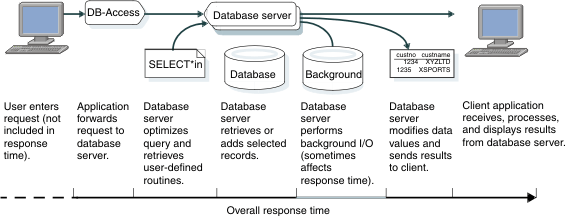Response time
Response time measures the performance of an individual transaction or query. Response time is typically treated as the elapsed time from the moment that a user enters a command or activates a function until the time that the application indicates that the command or function has completed.
The response time for a typical Informix® application
includes the following sequence of actions. Each action requires a
certain amount of time. The response time does not include the time
that it takes for the user to think of and enter a query or request:
- The application forwards a query to the database server.
- The database server performs query optimization and retrieves any user-defined routines (UDRs). UDRs include both SPL routines and external routines.
- The database server retrieves, adds, or updates the appropriate records and performs disk I/O operations directly related to the query.
- The database server performs any background I/O operations, such as logging and page cleaning, that occur during the period in which the query or transaction is still pending.
- The database server returns a result to the application.
- The application displays the information or issues a confirmation and then issues a new prompt to the user.
Figure 1 contains a
diagram that shows how the actions just described in steps 1 through
6 contribute to the overall response time.
Figure 1. Components of the response time for
a single transaction
